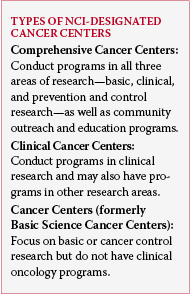Director's Update: March 16, 2004
On Monday, March 8, National Cancer Institute (NCI) convened a cancer centers directors' retreat in which 59 of 61 NCI-designated cancer centers participated. The purpose of the retreat was to discuss future opportunities and challenges and the critically important role that the cancer centers play in the National Cancer Program. New technology initiatives and ongoing implementation of the report of the NCAB P30/P50 Ad Hoc Working Group (chaired by Drs. Joe Simone and Art Nienhuis) were central themes. The retreat included the cancer center directors in strategic discussions to facilitate the discovery, development, delivery continuum.

 In the late 1960s, 12 cancer centers were NCI-funded. With the enactment of the National Cancer Act in 1971, the Cancer Centers Program formally established and funded 15 additional cancer centers. "The National Cancer Institute should closely study the use of cancer research centers," the legislation stated, "for it is here that many impressive research findings are being and will be uncovered. It is also here that the effectiveness of these findings can be proved." In fact, our cancer centers have become extraordinary gravitational forces attracting intellectual capital, financial resources, and programmatic opportunities.
In the late 1960s, 12 cancer centers were NCI-funded. With the enactment of the National Cancer Act in 1971, the Cancer Centers Program formally established and funded 15 additional cancer centers. "The National Cancer Institute should closely study the use of cancer research centers," the legislation stated, "for it is here that many impressive research findings are being and will be uncovered. It is also here that the effectiveness of these findings can be proved." In fact, our cancer centers have become extraordinary gravitational forces attracting intellectual capital, financial resources, and programmatic opportunities.
A significant portion of NCI's funding portfolio is vested in these cancer centers. To their great credit, the centers have leveraged this investment with contributions from academic institutions and private philanthropy to build programs in cancer research, nanotechnology, prevention, care, and education that receive world-wide acclaim. How are we then going to optimally utilize this enormous resource? By greater integration among cancer centers and greater coordination with NCI and health delivery systems. To assist in this integration and coordination among the cancer centers, a significant outcome of the retreat was enthusiastic agreement to immediately begin to adopt the cancer Biomedical Informatics Grid (caBIG) for clinical research. caBIG can immediately offer the cancer centers Web-based clinical trials protocol sharing, clinical trials data capture tools, and participant registry based on common vocabularies and data elements. Additionally, retreat participants discussed how to manage planned technology development to maximize capabilities across the cancer community. NCI continues to foster more integration among the intramural and extramural clinical research enterprises and state and regional cancer programs. We need to encourage geographic associations of groups that will increase their impact by affiliation - particularly in underserved areas.
Guidelines for the cancer centers are undergoing revision to simplify and provide for a more streamlined review process. Other priority areas:
- Allow salary support for clinical researchers who actively engage in translational research
- Provide more appropriate support for critical underfunded activities such as tissue banks, data management, and regulatory compliance
- Continue to study the value
of site visits
- Recognize collaborations with SPOREs, cooperative groups,
and networks
- Develop economies of scale
by centralizing Institutional
Review Boards
- Create shared core resources
The chance to share ideas among NCI leadership and the cancer center directors provided a valuable opportunity to synergize and integrate this important resource of the National Cancer Program; I plan to repeat it annually. I also reported on the retreat at the joint Board of Scientific Advisors/Board of Scientific Counselors meeting yesterday. For additional
information on the cancer centers and a list of the directors, see http://cancercenters.cancer.gov .
Andrew C. von Eschenbach, M.D.
Director, National Cancer Institute
|